Basilisk Lizard
Can run/walk on water.
Advertisement
Basilisk Lizard Scientific Classification
Read our Complete Guide to Classification of Animals.
Basilisk Lizard Conservation Status
Basilisk Lizard Facts
- Prey
- Insects, small lizards and mammals, spiders, snails, crawfish.
- Name Of Young
- Hatchlings
- Group Behavior
- Solitary
- Fun Fact
- Can run/walk on water.
- Biggest Threat
- Pollution and habitat destruction.
- Most Distinctive Feature
- Bright colors and whip-like tail.
- Other Name(s)
- Common basilisk lizard, western basilisk lizard, red-headed basilisk lizard, plumed basilisk lizard, green basilisk lizard, double-crested basilisk lizard, brown basilisk lizard, striped basilisk lizard.
- Gestation Period
- 8-10 weeks
- Litter Size
- 20 eggs
- Habitat
- Tropical rainforests
- Predators
- Large birds, snakes, fish, quetzals, other reptiles, nocturnal mammals.
- Diet
- Carnivore
- Type
- Reptile
- Common Name
- Basilisk
- Number Of Species
- 4
- Location
- South America
- Group
- Solitary
View all of the Basilisk Lizard images!
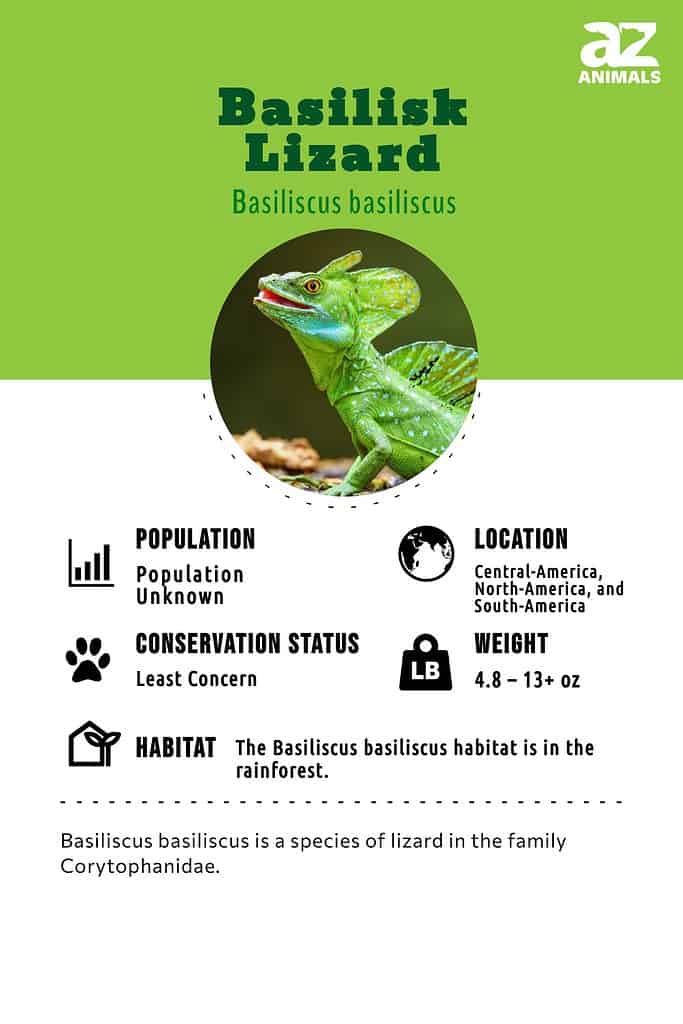
The basilisk lizard, or the basilisk, is a beautiful but quite unpleasant reptile to be around.
They love spending their days in the rainforest near rivers and streams, which they can run quickly across without ever sinking.
Pay attention to their colors to help in your identification of each of the four species. While one species may only have brown and cream colors, another has bright green hues that let them blend with the lush Central and South American environment.
5 Incredible Basilisk Lizard Facts!
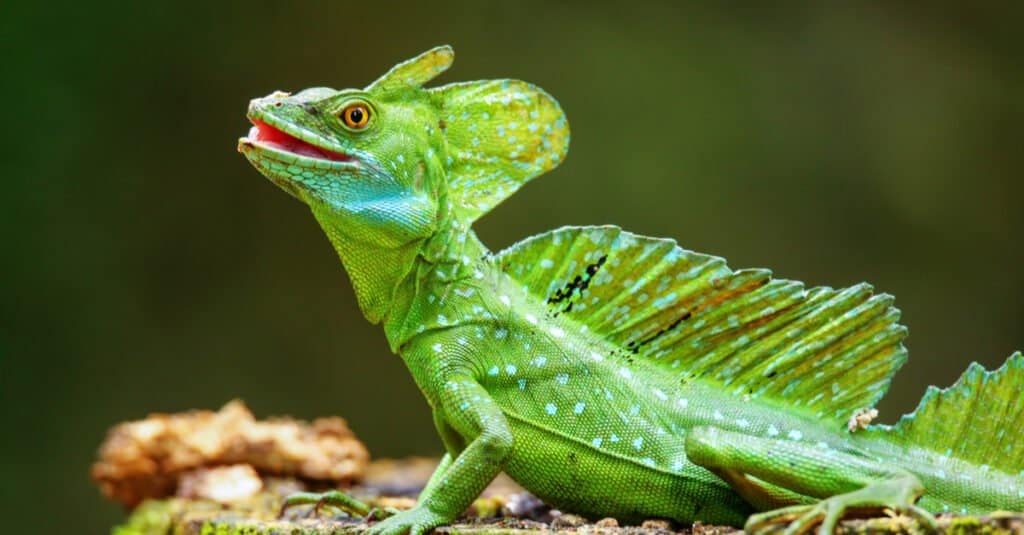
Male plumed basilisk (Basiliscus plumifrons) sitting on a stump, Costa Rica.
©Don Mammoser/Shutterstock.com
Here are some fun facts about this lizard.
- The basilisk lizard is sometimes simply known as the basilisk.
- When running, this lizard can reach a speed of 15 mph.
- Due to their ability to run on water, the basilisk lizard is sometimes referred to as the Jesus lizard, referencing the story of Jesus Christ walking on water in the Bible.
- Their price is fairly low to purchase as a pet, starting at just $3. However, the price may be as high as $20 with some distributors.
- One of the many adaptations of the basilisk is its feet’s fringes. These adaptations make it possible for the lizard to run on the water’s surface without sinking.
Scientific Name
The basilisk lizard’s scientific name is Basiliscus, which is the genus that covers four different species – B. plumifrons, B. basiliscus, B. galeritus and B. vittatus. They are a part of the Corytophanidae of the Reptilia class. The name comes from the Greek word “basilískos,” which literally means “little king.”
Evolution and Origins
Due to its propensity to skim the water’s surface over short distances, the ancient species is also the earliest ancestor of the modern basilisk, commonly known as the Jesus Lizard. At 48 million years ago, Wyoming’s tropical rainforests were home to the earliest Corytophanidae.
The tropical jungles of Costa Rica, Honduras, Nicaragua, and Panama are home to green-crested basilisks. They live at heights between sea level and 2,542 feet and are regarded as semi-arboreal and semi-aquatic.
The green basilisk’s long-toed back legs, fringed skin, and unique scales on its feet enable it, like other basilisk lizards, to race across the water. Its feet smack the ground as it moves, generating an air pocket that keeps them from sinking.
Appearance
Part of the reason that the basilisk lizard is so interesting among the public is because of its incredible colors. Depending on the species, you’ll be able to find them in reds, greens, blues, and even yellows. The colors of the lizard help with the identification of which species they may be.
The common basilisk, for example, is brown and creamy. The plumed basilisk, on the other hand, ranges from bright to dark green, and some even end up a blue-green. Identification is easy because they often have a yellow belly and spots along their neck.
In general, the tail accounts for about 75% of the lizard’s total length. The average length (with the tail) is about 2.5 feet long. Their feet feature unique adaptations – like hinges and hollow bones – to help keep them on top of the water.
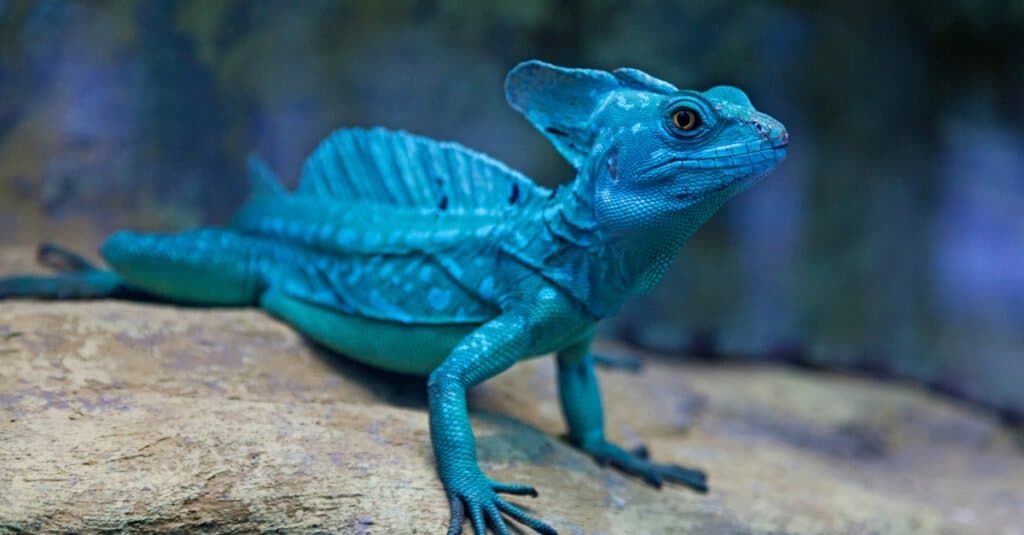
©Peter Ekvall/Shutterstock.com
Behavior
As beautiful as the basilisk lizard is, make sure you never approach one in the wild. They are not friendly, and they become very skittish and afraid around humans. They are known for running on water to allow them to run away from predators and run toward their prey.
The lizards prefer to live a solitary lifestyle. Their days are often busy with foraging for food or spending time in the sun by the water. If they choose to sleep in a tree, they can go up to 20 meters high.
Habitat
If you want to find a basilisk lizard, you’ll need to travel to Central America and South America. This type of lizard prefers to live in the rainforest, staying close to the water that they like to run across. They’ll find places near rivers and streams, which are also their main hunting grounds.
These creators are semi-aquatic and semi-arboreal, living at elevations of up to 775 meters.
Diet
The diet of the basilisk lizard varies from one species to the next, but they are generally omnivores. They prefer to eat winged insects, though they will eat smaller prey that is available by the water near which they live. Their diet is 20% to 30% plant matter, and the rest is a combination of insects, spiders, small mammals, snails, and smaller lizards.
Predators and Threats
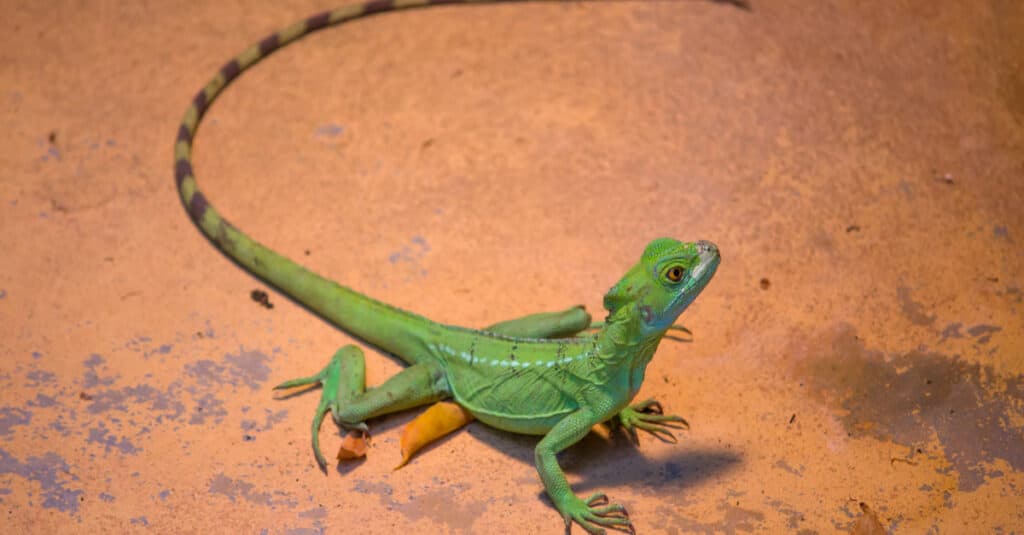
Green crested basilisk lizard sitting on the desert sand.
©Vladislav Gajic/Shutterstock.com
The basilisk lizard is a worthy predator, feeding primarily on insects. To catch them, the lizard seeks out prey in trees or even in the air.
They will run after their prey until they catch it, though their food comes much more easily as a pet. Running on the water is helpful to both their hunting and their escape from being hunted. When it is running on water, it can reach a speed of 15 mph.
As a pet, basilisk lizard babies require up to three meals a day, gathering as much as they can eat within just ten minutes. Just over 70% of their diet consists of insects and other animal life, while the rest is plant matter.
What Eats Basilisk Lizards?
Common predators of these lizards include large birds, snakes, fish, and other reptiles. The biggest predator for basilisks is the quetzal, which is a type of bird.
Diet
Each basilisk has an assortment of different foods that they eat. While all four species are omnivorous, the plumed basilisk lizard (also known as the green basilisk lizard) primarily prefers to follow a carnivorous diet. They stay close to the water so they can eat frogs and fish.
The redhead basilisk primarily eats insects, but they’ll look for arthropods, small vertebrates, and fish. The common basilisk lizard prefers a similar diet, though they’ll also consume freshwater shrimp, small birds, small reptiles, and small mammals. Juvenile common basilisks tend to rely mostly on insects as their source of nutrients.
The brown basilisk tends to be the most flexible with its diet, acting more opportunistically. They tend to eat aquatic larvae, insects, grasshoppers, and scorpions when they have the choice.
Reproduction and Life Cycle
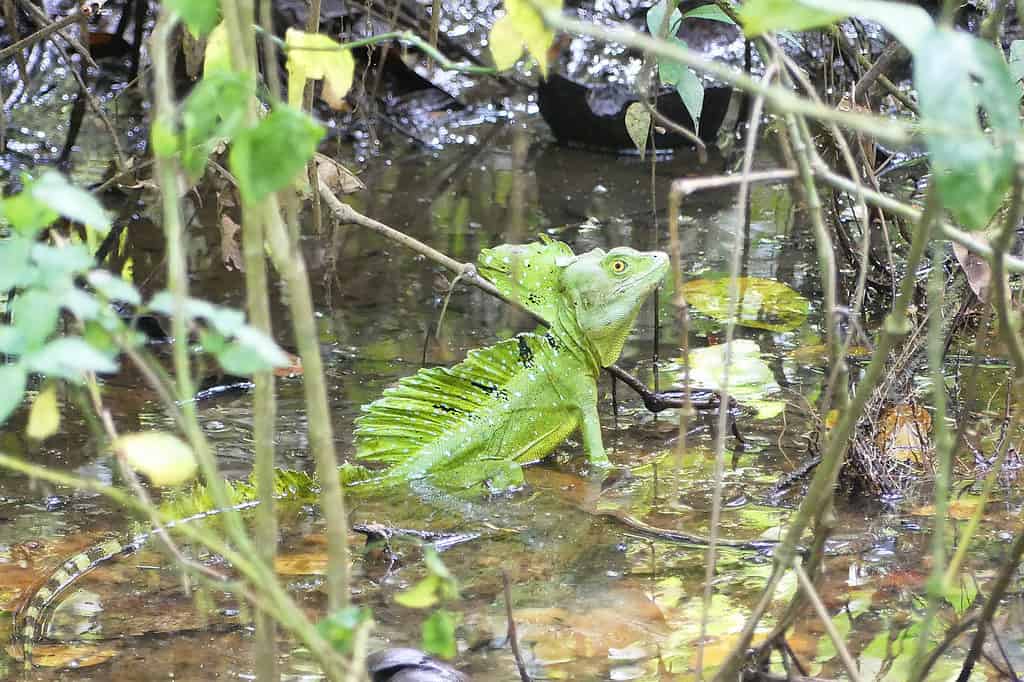
Green basilisk (Basiliscus plumiforms) or Jesus Christ lizard. This impressive lizard can run over water! This one takes a rest.
©fernandoul/Shutterstock.com
Mating between these lizards is a unique process. While females only mate with one male during the mating season, males will take multiple partners.
The females often lay up to 4 clutches during the year, each of which is up to 20 eggs. The female lays the eggs in a trench and doesn’t take any time to care for them. She leaves them behind, and the babies hatch within 8-10 weeks, though it takes about 2 days for these lizards to fully come out of the shell during their life cycle.
From the moment these babies – also known as hatchlings – are born, they can immediately run-on land and water. They can also swim and climb from birth. They have no care from their mother or father as babies, and they reach sexual maturity as early as 10 months old, even though they are far smaller than their eventual adult size. Most of the time, females reach sexual maturity at a much faster rate.
The average lifespan of this lizard is 7 years when it is kept in captivity. In the wild, they are in constant peril as they protect themselves from predators, so they don’t have quite as long to live through their life cycle.
Population
In the entire world, there are four different species of this lizard in the world, which include the common basilisk lizard, red-headed basilisk lizards, plumed basilisk lizards (also known as a green basilisk lizard), and striped basilisk lizards.
While the total number of each of these species remains unknown, the IUCN classifies them all as “not extinct.” Currently, one of the biggest challenges to the worldwide population of this lizard is humans, as they are the reason behind their loss of habitat. The quetzal, a bird, is one of the natural challenges it faces in the animal kingdom.
View all 285 animals that start with BBasilisk Lizard FAQs (Frequently Asked Questions)
What is a basilisk lizard?
This lizard is a reptile that primarily lives in Central America and South America. It lives near rivers and streams, and it can be found in many different colors. When in captivity, it has a potential lifespan of 7 years. It has an insectivorous diet, and it is commonly referred to as a Jesus lizard because of the way it is known for running on water.
Are basilisk lizards good pets?
The main reason that so many people adopt basilisk lizards is because of their beauty. However, they aren’t the friendliest of creatures, so they may not be a good option for people who want to have pets they can handle. They are skittish, easy to anger, and quite shy, so they won’t want to come out of their enclosure often.
Is the basilisk lizard poisonous?
No, this lizard is not poisonous.
What do basilisk lizards eat?
The primary diet of the basilisk is insects.
Why are basilisk lizards called basilisks?
The name “basilisk directly correlates with the monster of the same name.
How do I get rid of basilisk lizards?
Since these lizards are attracted to water, they tend to hang around lakes, ponds, and even pools. Sprinkling pest control granules and spray is the easiest way to fix this problem, protecting your home before the problem worsens.
Can you buy a basilisk lizard?
Yes. The typical price for a basilisk lizard is $3 to $20. The most commonly sold basilisk in the pet trade industry is the striped basilisk lizard, though you are likely to face many challenges in keeping this animal in your home.
How long does a basilisk live?
When kept in captivity, the basilisk lizard typically lives to be 7 years old. However, in the wild, there are many predators that threaten their lifespan, so they don’t live quite as long.
Can a basilisk lizard regrow its tail?
No. While many lizards can regrow their tail, the basilisk lizard is not one of them.
How big of a tank does a basilisk lizard need?
Pet owners need to get a fairly large tank for their lizard. If you choose to get two or three basilisk lizards together, the best enclosure is at least 3’ long, 3’ wide, and 4’ tall. You’ll need to include many branches for them to climb.
How does the basilisk lizard run on water?
The reason that this lizard can run so fast on the water is because of the fringes of skin on their toes, spreading out while they are on the water. They run quickly, allowing them to stay afloat.
How long can a basilisk lizard run on water?
This lizard can make it across 33 to 66 feet of water while running.
Are basilisk lizards carnivores, herbivores, or omnivores?
They are omnivores, but the majority of their diet is made of lizards.
Thank you for reading! Have some feedback for us? Contact the AZ Animals editorial team.
Sources
- ITIS, Available here: https://www.itis.gov/servlet/SingleRpt/SingleRpt?search_topic=TSN&search_value=683025#null
- Pets on Mom, Available here: https://animals.mom.com/basilisks-eat-11298.html
- Adapting Eden, Available here: https://www.adaptingeden.com/rainforest_animals/green-lizard-basilisk/
- Prezi, Available here: https://prezi.com/nw-32x1dhxjs/adaptations-of-the-basalisk-lizard/
- San Francisco Zoo & Gardens, Available here: https://www.sfzoo.org/plumed-basilisk/
- Wikipedia, Available here: https://en.wikipedia.org/wiki/Common_basilisk
- Wikipedia, Available here: https://en.wikipedia.org/wiki/Quetzal
- Adapting Eden, Available here: https://www.adaptingeden.com/rainforest_animals/green-lizard-basilisk/
- Northampton Reptile Centre, Available here: https://www.reptilecentre.com/info-green-basilisk-care-sheet
- Reptiles, Available here: https://reptilesmagazine.com/basilisk-lizard-information-and-care/
- Wonderopolis, Available here: https://wonderopolis.org/wonder/how-does-the-basilisk-lizard-run-on-water

















